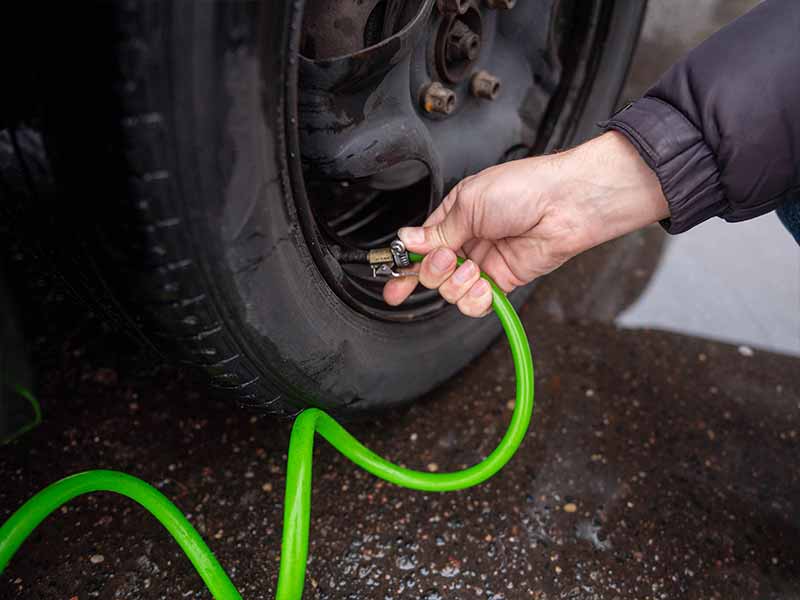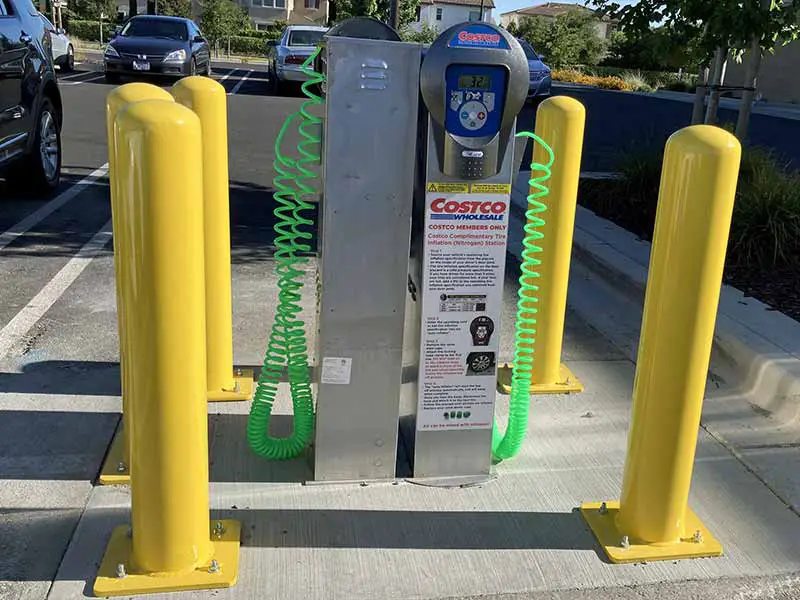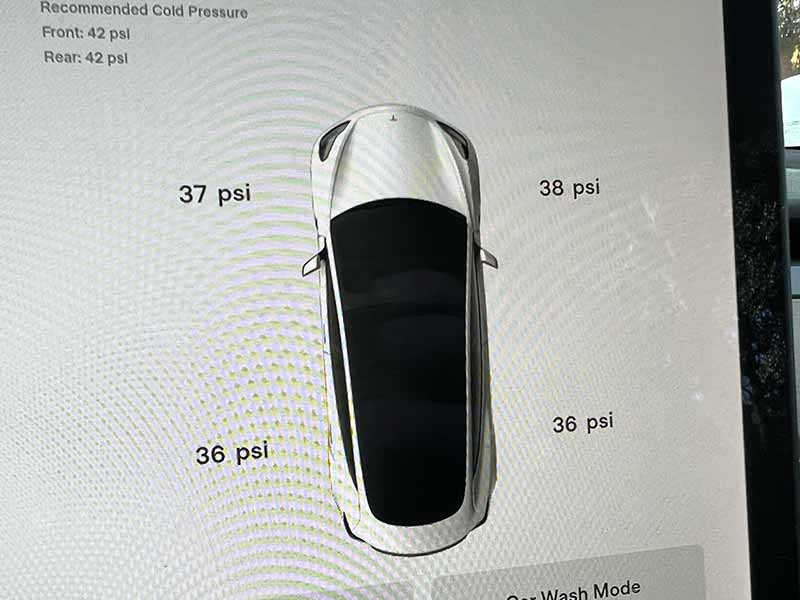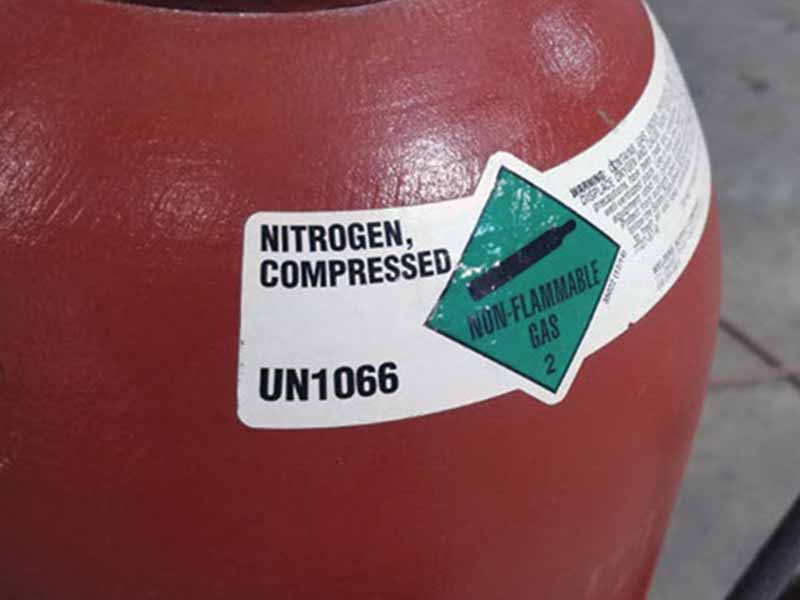Properly inflated tires can improve fuel efficiency by up to 3%. Not on that, but according to the NHTSA, under-inflated tires contribute to more than 33,000 injuries and 660 fatalities in the United States each year.
These are just a couple of reasons why it’s important to know how to check the pressure and maintain those nitrogen-filled tires.
How To Check Nitrogen Tire Pressure
To check nitrogen tire pressure you don’t need special equipment. Use a normal tire pressure gauge and make sure the pressure matches the air pressure listed on the tire information sticker in the driver’s door jamb.
In this easy-to-understand guide, we’ll explore the differences between nitrogen and air-filled tires, how to find the correct PSI for your tires, and what happens when you mix air with nitrogen. You’ll also learn how often you should check the pressure of your tires and some helpful tips to keep them in great shape.
Let’s take a closer look.

PSI For Nitrogen-Filled Tires
Knowing the right tire pressure, or PSI (pounds per square inch), is important for both nitrogen-filled and air-filled tires. In this section, we’ll explain that the recommended PSI is the same for both types of tires and how to find the correct PSI for your tires.
Same Pressure Recommendations
Whether your tires are filled with nitrogen or air, the recommended tire pressure stays the same. It’s important to follow the PSI guidelines given by your car’s manufacturer to make sure your tires are properly inflated. This helps your car drive smoothly, use less gas, and keeps you safe on the road.
Finding the Correct PSI
To find the right PSI for your tires, you can check a few places:
- Owner’s Manual: Look in your car’s owner’s manual for the suggested tire pressure. This is a small book that comes with your car and has lots of information about your vehicle.
- Doorjamb: On the inside of the driver’s door, there’s usually a sticker that shows the recommended PSI for your tires. This is a quick and easy way to find the right tire pressure.
- Tire Sidewall: Sometimes, you can find the maximum PSI on the side of your tire. But remember, this is the highest pressure the tire can handle, not the recommended pressure for your car.
Once you know the correct PSI for your tires, you can use a tire pressure gauge to check if your tires are inflated properly. It’s important to do this for both nitrogen-filled and air-filled tires to make sure your car is safe and works well.

How Often To Check Nitrogen-Filled Tires
Checking your tire pressure is important for keeping your car running smoothly and safely. In this section, we’ll talk about how often you should check the pressure of nitrogen-filled tires and compare it to the recommended checks for air-filled tires.
Monthly Checks for Air-Filled Tires
If your tires are filled with regular air, it’s a good idea to check the tire pressure once a month. This helps make sure your tires are properly inflated and can prevent problems like flat tires, uneven tire wear, or poor gas mileage.
Nitrogen-Filled Tire Checks
For nitrogen-filled tires, you might not need to check the pressure as often. This is because nitrogen-filled tires tend to lose pressure more slowly than air-filled tires. However, it’s still important to check your tire pressure regularly, even if you have nitrogen-filled tires.
Tires filled with nitrogen should lose air 3 times more slowly, but it may not be wise to only check their air pressure every 3 months. You should check nitrogen tire pressure monthly and then wait longer between checks if the difference in pressure is small enough that you don’t need to adjust the pressures.
Factors Affecting Tire Pressure Loss
Several things can cause your tires to lose pressure, including:
- Temperature Changes: When the weather gets colder or warmer, the pressure in your tires can change. This is true for both nitrogen-filled and air-filled tires, although nitrogen-filled tires are less affected by temperature changes.
- Small Leaks: Sometimes, tiny leaks in your tires can cause them to lose pressure. Checking your tire pressure regularly can help you find these leaks before they cause a flat tire.
- Time: Over time, tires naturally lose pressure. That’s why it’s important to check your tire pressure regularly, no matter what type of tires you have.
While nitrogen-filled tires may not need to be checked as often as air-filled tires, it’s still important to check your tire pressure regularly. This helps make sure your tires are properly inflated and can prevent problems that could make driving unsafe or less efficient.

Can You Put Air In Nitrogen-Filled Tires?
Sometimes you might wonder if it’s okay to put regular air in your tires if they’re filled with nitrogen. In this section, we’ll talk about what happens when you mix nitrogen and air in your tires and if it’s okay to do this.
Mixing Nitrogen and Air
It’s not harmful to mix nitrogen and regular air in your tires. If you’re in a situation where you can’t find a place to fill your tires with nitrogen, it’s okay to use regular air to top them off. However, it’s important to know that adding air to nitrogen-filled tires might reduce some of the benefits of using nitrogen.
What Happens When You Mix
When you mix nitrogen and air in your tires, you might notice a few changes:
- Faster Pressure Loss: One of the benefits of using nitrogen is that it helps your tires stay full longer. If you add regular air to your tires, they might lose pressure more quickly than if they were filled with just nitrogen.
- Less Stable Pressure: Nitrogen is better at keeping a steady pressure in your tires, even when the temperature changes. Mixing air with nitrogen might make the pressure in your tires change more often, which could affect how your car drives.
- Shorter Tire Life: Nitrogen can help your tires last longer because it doesn’t damage the rubber and metal parts inside as quickly as air does. When you mix air with nitrogen, your tires might not last as long as they would with just nitrogen.
It’s okay to put air in your nitrogen-filled tires if you need to. But keep in mind that mixing nitrogen and air might reduce some of the benefits of using nitrogen. If possible, try to find a place that fills tires with nitrogen to help keep your tires working their best.

Nitrogen Vs Air In Tires
When you fill your tires, you can choose between nitrogen and regular air. In this section, we’ll talk about why some tire shops use nitrogen and if the benefits are worth the extra trouble and cost.
Reasons for Using Nitrogen in Tires
- Better Gas Mileage: Nitrogen molecules are bigger than oxygen molecules, so they don’t leak out of your tires as easily. This means your tire pressure stays more constant, which can help your car use less gas.
- Tires Stay Full Longer: Nitrogen-filled tires lose air more slowly than regular air-filled tires. This is because nitrogen isn’t affected by temperature changes as much, so it keeps a steadier pressure.
- Tires Last Longer: Nitrogen doesn’t react with other things as much as oxygen does, so it doesn’t damage the rubber and metal parts in your tire as quickly. This can make your tires last longer and help avoid sudden flat tires.
Benefits and Drawbacks
There are some good things about using nitrogen in your tires, but there are also some problems to think about.
- Harder to Find: Not all tire shops have nitrogen, so you might have to look for a special shop or buy your own nitrogen tank. This can take extra time and be a hassle.
- Costs More: Filling your tires with nitrogen usually costs more than using regular air. Also, because nitrogen isn’t as easy to find as air, you might have to pay more to use nitrogen refill stations.
In the end, nitrogen-filled tires have some good things, like better gas mileage and tires that stay full longer. But these good things might not be worth the extra trouble and cost for everyone. It’s important to think about the good and bad points and decide if nitrogen-filled tires are the best choice for you and how you drive.
Resources
Below are some links you may find helpful when learning about tires
- What are the benefits of nitrogen-filled tires? – Continental Tires
- Is nitrogen better than air for your tires? – Discount Tire
Final Thoughts
Checking and maintaining the right tire pressure is important for every driver, whether you’re using nitrogen-filled tires or regular air-filled tires. Remember, keeping your tires at the correct PSI can help you stay safe on the road, save money on gas, and make your tires last longer.
As you’ve learned, nitrogen-filled tires have some unique benefits, but they still require regular care and attention. So, keep a tire pressure gauge handy, know where to find a nitrogen refill station, and never be afraid to ask for help if you’re unsure about something.
As the famous American inventor Thomas Edison once said, “There’s a way to do it better—find it.” By learning how to check nitrogen tire pressure and understanding the benefits and drawbacks of nitrogen-filled tires, you’re on your way to finding a better way to care for your tires and stay safe on the road.
Good luck and happy motoring.




